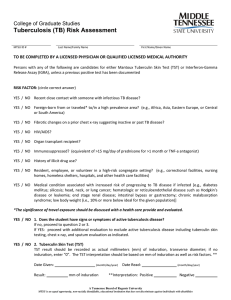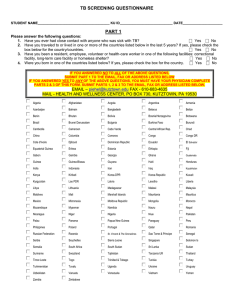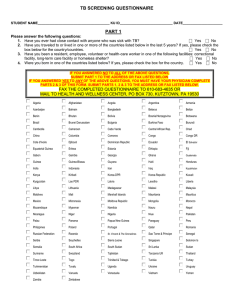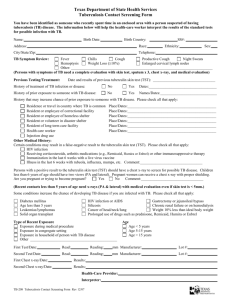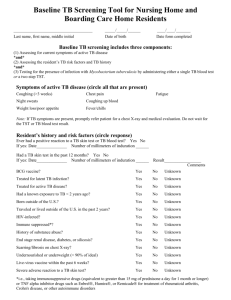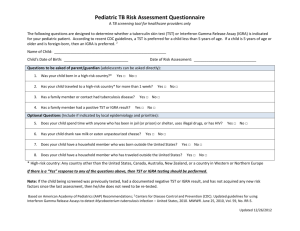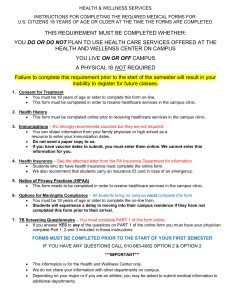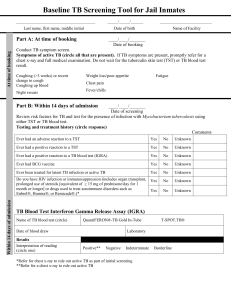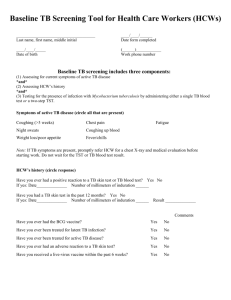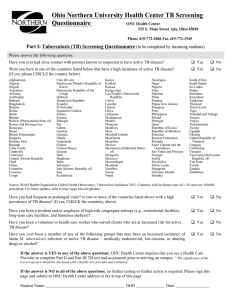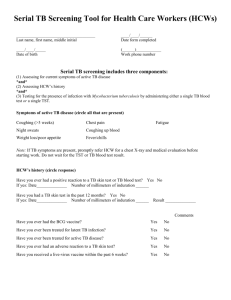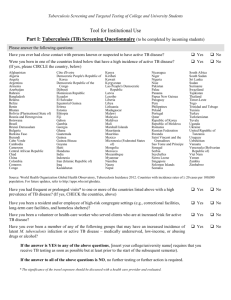MARIST
advertisement
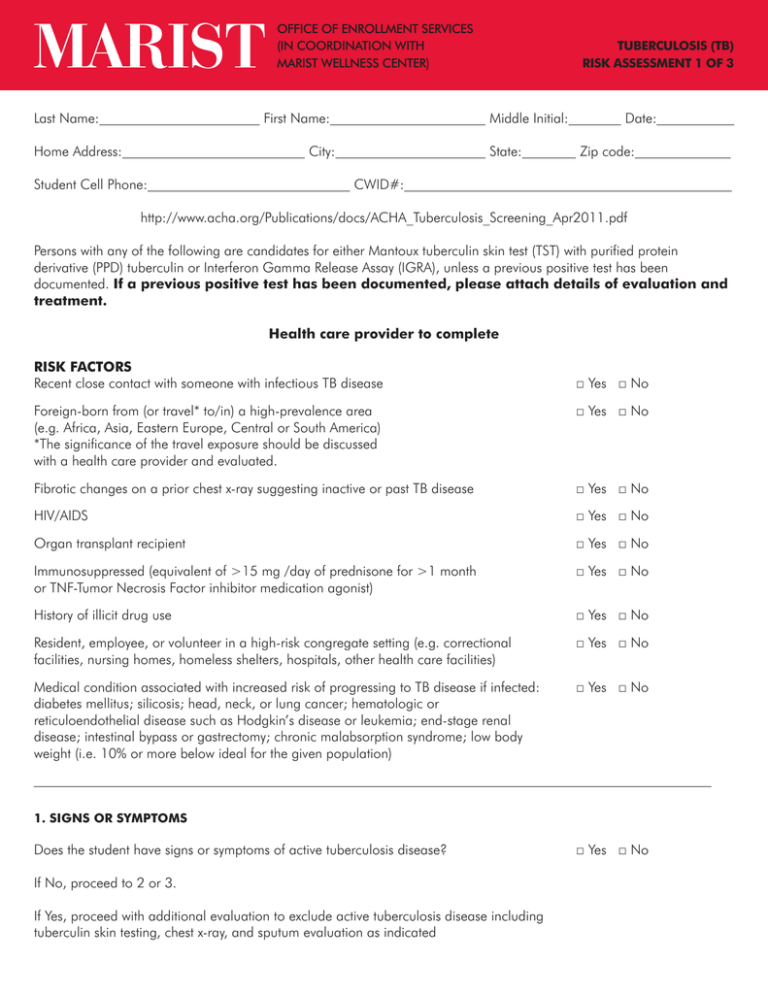
MARIST OFFICE OF ENROLLMENT SERVICES (IN COORDINATION WITH MARIST WELLNESS CENTER) TUBERCULOSIS (TB) RISK ASSESSMENT 1 OF 3 Last Name: First Name: Middle Initial: Date: Home Address: City: State: Zip code: Student Cell Phone: CWID#: http://www.acha.org/Publications/docs/ACHA_Tuberculosis_Screening_Apr2011.pdf Persons with any of the following are candidates for either Mantoux tuberculin skin test (TST) with purified protein derivative (PPD) tuberculin or Interferon Gamma Release Assay (IGRA), unless a previous positive test has been documented. If a previous positive test has been documented, please attach details of evaluation and treatment. Health care provider to complete RISK FACTORS Recent close contact with someone with infectious TB disease □ Yes □ No Foreign-born from (or travel* to/in) a high-prevalence area (e.g. Africa, Asia, Eastern Europe, Central or South America) *The significance of the travel exposure should be discussed with a health care provider and evaluated. □ Yes □ No Fibrotic changes on a prior chest x-ray suggesting inactive or past TB disease □ Yes □ No HIV/AIDS □ Yes □ No Organ transplant recipient □ Yes □ No Immunosuppressed (equivalent of >15 mg /day of prednisone for >1 month or TNF-Tumor Necrosis Factor inhibitor medication agonist) □ Yes □ No History of illicit drug use □ Yes □ No Resident, employee, or volunteer in a high-risk congregate setting (e.g. correctional facilities, nursing homes, homeless shelters, hospitals, other health care facilities) □ Yes □ No Medical condition associated with increased risk of progressing to TB disease if infected: diabetes mellitus; silicosis; head, neck, or lung cancer; hematologic or reticuloendothelial disease such as Hodgkin’s disease or leukemia; end-stage renal disease; intestinal bypass or gastrectomy; chronic malabsorption syndrome; low body weight (i.e. 10% or more below ideal for the given population) □ Yes □ No 1. SIGNS OR SYMPTOMS Does the student have signs or symptoms of active tuberculosis disease? If No, proceed to 2 or 3. If Yes, proceed with additional evaluation to exclude active tuberculosis disease including tuberculin skin testing, chest x-ray, and sputum evaluation as indicated □ Yes □ No MARIST OFFICE OF ENROLLMENT SERVICES (IN COORDINATION WITH MARIST WELLNESS CENTER) TUBERCULOSIS (TB) RISK ASSESSMENT 2 OF 3 Last Name: First Name: CWID#: 2. HOW TO TEST At the present time, the Mantoux test is the only acceptable TST. To perform this test, inject 0.1ml of purified protein derivative (PPD) tuberculin containing 5 tuberculin units (TU) intradermally into the volar (inner) surface of either forearm. A history of BCG vaccination should not preclude tuberculin skin testing of students. TST can be administered during pregnancy. If a student has recently received a live virus vaccination, skin testing should be delayed for 4-6 weeks after the student received the vaccination. However, a TST can be performed on the same day as live virus administration without compromising the integrity of the result. Two-step testing is particularly important and should be considered for the initial skin testing of persons who will be retested periodically, e.g. health profession students, workers, and volunteers. Two-step testing is more reliable in identifying remote infection (e.g. infection in childhood). If the first test is positive, the person should be considered infected. If the first test is negative, a repeat test should be administered 1-3 weeks later. If the second test is positive, consider the person infected. If there is documentation of a negative TST within the prior 12 months, only one TST needs to be done, and this is considered the second of the two-step tests. 3. HOW TO INTERPRET THE TST TST result should be recorded as actual millimeters (mm) of induration, transverse diameter; if no induration, write “0”. The TST interpretation should be based on mm of induration as well as risk factors. Date given: Date read: RESULT: Date given: / / / / Lot #: Administered by _______________________________________ Read by: mm induration INTERPRETATION: □ positive □ negative / / / Lot #: Administered by _______________________________________ Date read: / Read by: RRESULT: mm induration INTERPRETATION: □ positive □ negative >5mm is positive in the following: • Recent close contacts of an individual with infectious TB • Persons with fibrotic changes on a prior chest x-ray, consistent with past TB disease • Organ transplant recipients • Immunosuppressed persons: taking equivalent of >15 mg prednisone for > 1 month; taking a TNH-Tumor Necrosis Factor inhibitor medication antagonist >10 mm is positive in the following: • Persons born in a high prevalence country or who resided in one for a significant* amount of time • History of illicit drug use • Mycobacteriology laboratory personnel • History of resident, worker, or volunteer in high-risk congregate settings • Persons with the following clinical conditions: silicosis; diabetes mellitus; chronic renal failure; leukemias and lymphomas; head, neck or lung cancer; low body weight (>10% below ideal); gastrectomy or intestinal bypass; chronic malabsorption syndromes. >15 mm is positive in the following • Persons with no known risk factors for TB disease MARIST OFFICE OF ENROLLMENT SERVICES (IN COORDINATION WITH MARIST WELLNESS CENTER) TUBERCULOSIS (TB) RISK ASSESSMENT 3 OF 3 Last Name: First Name: CWID#: 4. INTERFERON GAMMA RELEASE ASSAY (IGRA) Date obtained: / (specify method) □ QFT-G □ QFT-GIT □ T-Spot □ other / Result: □ negative □ positive □ indeterminate □ borderline □ (T-spot only) 5. CHEST X-RAY: (REQUIRED IF TST OR IGRA IS POSITIVE) Date of chest x-ray: / / Result: □ normal □ abnormal □ (attach full interpretation) What to do when the TST or IGRA is positive Persons with a positive TST or IGRA must undergo chest radiography and medical exam. If any x-ray changes or signs and symptoms of active TB are identified, active TB disease must be excluded. If the chest x-ray and medical exam are normal, treatment for latent tuberculosis infection (LTBI) is recommended since this greatly reduces the risk of TB infection progressing to TB disease in the student and serves to reduce the burden of TB in the United States. Treatment is most important for those with a particularly high risk for progression from latent infection to active disease including individuals who had a TST conversion within 2 years and those with HIV/AIDS or other clinical conditions associated with a suppressed immunity. Treatment with INH daily for nine months is the preferred regimen; however other regimens may be appropriate. (www. cdc.gov/tb/pubs/LTBI/treatment.htm: Guide for Primary Health Care Providers: Targeted Tuberculin Testing and Treatment of LTBI.) Completion of treatment is a high priority. Students can be followed monthly while at Marist College and monitored for compliance with and possible side effects of or adverse reactions to treatment. Post-treatment follow up should include providing the student documentation of TST or IGRA results, chest radiograph results, and the dosage and duration of medication treatment. Students who have completed LTBI therapy should be educated regarding signs and symptoms of TB disease and instructed to seek medical care immediately up on developing any signs or symptoms of TB. 6. DETAILS OF RECOMMENDATION AND TREATMENT: Health care provider name printed: Health care provider signature: Date: Address: City: State: Zip code: Phone: Fax:
